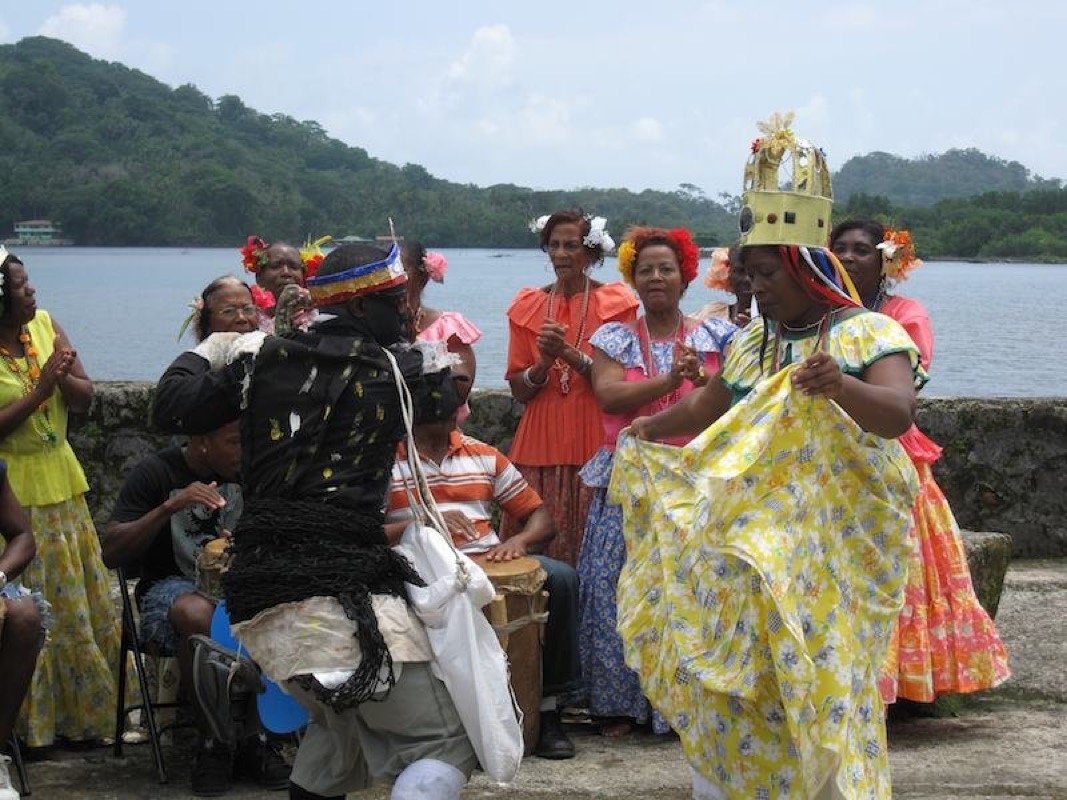Congo King and Queen (Photo by Oronike Odeleye)
Both the Queen—“Maria Merced” or “Mercedes”—and King—“Juan de Dioso” or “Juan de Dios”—are distinguished by their crowns, which are made of cardboard, decorated in gold fabric, and adorned with convenient materials like large colorful rhinestones, mirrors, and/or bows. The Queen’s crown is further embellished with multicolored ribbons, which flow from its back rim like streamers. In addition to her crown, the Queen is distinguished by a large cross, which she uses to protect herself and her community from the Devil.
The Queen’s costume, consistent with other Congo women’s costumes, includes a pollera, a white sleeveless or short-sleeve blouse, a petticoat, layers of beads called lágrimas de la Virgen (tears of the Virgin Mary), and one or two flowers pinned in the hair. The polleras are generally made of eight yards of inexpensive cotton material with a pattern of small flowers. The blouses feature a frilly collar matching the pattern of the skirt. Often in the style of their mothers and grandmothers, Congo women wear patchwork polleras made of recycled older ones and other discarded fabric.
Unlike the women, the King and Congo men paint their faces with charcoal or indigo and wear both trousers and a long-sleeved shirt or jacket turned inside out.
Unlike the women, the King and Congo men paint their faces with charcoal or indigo and wear both trousers and a long-sleeved shirt or jacket turned inside out. Recounting a memory of watching her father get dressed as the Congo King, Simona Esquina shared:
All of my life, from the time I peeled opened my eyes, [my father] was Juan de Dios of the Congos. He was the King of the Congos. His Congo name was Juan de Dios but his birth name was Vicente Esquina. I would see him dress as a Congo with his clothes and rope [belt], lots of banana leaves tied on. [. . .] His crown and face painted blue-black. [. . .] then you put on black circles and your red lips. [. . .] He would use charcoal. [. . .] But first he would put on the blue [indigo]. He would get a little bit of water. He would paint his whole face with that, then he would put on black circles with charcoal, and I would watch him as a child. When I would see him painting his face I would ask him, daddy, where are you going? He would say, daughter, I’m going to Congo. [. . .] I’m going to Congo because I’m Juan de Dios and I have to be there together with my women. So then as a child I would go. I would see them dancing Congo and that’s how I began. [. . .] I enjoyed it.
Male Congo practitioners’ costumes also include a cone-shaped hat. Whereas the contemporary Congo hat is formed by layers of papier-mâché and adorned with mirrors, beads, and feathers, Simona explained that the traditional Congo hat was made from foliage: “Normally, here, the Congo hat has been the kafucula. The kafucula is the leaf of a coconut tree. That’s the original Congo hat. The Congo adorns the kafucula—he puts on his decorations, feathers, and colorful objects. So the kafucula is the hat, but Congos from other places use whatever [kind of hat, and that is outside the norm].” Expanding upon the Congo costume, she said:
The outfit of the Congos of Portobelo is very different from the outfit of the Congos of Colón, Costa Abajo, and Panama [city]. The Congo here dresses very distinctly. [. . .] There, the Congos dress using lots of bits of torn pieces of fabrics. [. . .] Yes, they all dress like that. In Colón and Panama City, the Congos dress like that. Everybody with little bits of torn fabric. But not here. Here, the Congos don’t dress like that. When you see a Congo here dressed with those pieces of torn fabric, you know that he’s not from Portobelo. He’s not from Costa Arriba.
Each Congo man carries a satchel over his shoulder to collect provisions and wears a belt of artifacts (plastic flashlights, coconut shells, plastic dolls) tied around his waist with a rope. Like the women, men wear layers of long beaded necklaces and stylize their costumes according to taste. During the 2003 Centennial, for example, a Congo elder made part of her pollera from a large Panamanian flag while Congo artists like Yaneca Esquina (pictured above) and his son Gustavo speckled their jackets and pants with paint in the pointillist style of their Congo paintings.
According to Melba Esquina, “As the Black was treated like an animal, they gave themselves animal names [for the Congo drama]: Rabbit, Sparrow-Hawk, Small Tiger, etc.” When I spoke with him, Carlos Chavarría elaborated:
The Congos would use purely animal names for themselves, for example, Ocelot, Fox, Pig, Rabbit. [. . .] Some would use names like Doctor, others [would use] Lawyer, but that was really unusual because most people used strictly animal names, and only occasionally used names of professions, right? But when they did you would see them with a book. If they were a lawyer, they used a book [as a prop]. If an Engineer, you would see them with their tape measure. If they were a doctor, they’d have a stethoscope. They may be presenting as that, but they were always imitating. [. . .] But if you were going to be seen as that, it was something you lived.
Throughout Carnival season Congo male practitioners alternate between drumming, dancing, and engaging in buffoonery as a tactic of subversion, misdirection, and evasion.
Excerpted from “Chapter Two,” When the Devil Knocks: The Congo Tradition and the Politics of Blackness in 20th Century Panama, The Ohio State University Press (in press)

